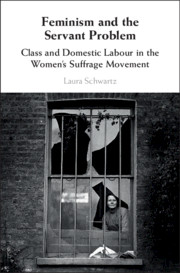Book contents
- Feminism and the Servant Problem
- Feminism and the Servant Problem
- Copyright page
- Contents
- Figures
- Acknowledgements
- Introduction
- 1 The ‘Servant Problem’ and the Suffrage Home
- 2 Servants in the Suffrage Movement
- 3 The Housework Problem
- 4 Domestic Labour and the Feminist Work Ethic
- 5 The Domestic Workers’ Union of Great Britain and Ireland
- 6 Servants and Co-operative Housekeeping
- Conclusion
- Select Bibliography
- Index
Conclusion
Published online by Cambridge University Press: 19 July 2019
- Feminism and the Servant Problem
- Feminism and the Servant Problem
- Copyright page
- Contents
- Figures
- Acknowledgements
- Introduction
- 1 The ‘Servant Problem’ and the Suffrage Home
- 2 Servants in the Suffrage Movement
- 3 The Housework Problem
- 4 Domestic Labour and the Feminist Work Ethic
- 5 The Domestic Workers’ Union of Great Britain and Ireland
- 6 Servants and Co-operative Housekeeping
- Conclusion
- Select Bibliography
- Index
Summary
The idea for this book began a long time ago, when I was writing the history of an Oxford women’s college and trying to find ways of understanding the often-ignored presence of domestic workers in this feminist-minded institution. During that time, I read Alison Light’s Mrs Woolf and the Servants and was compelled by her argument that ‘the history of service is the history of British women’. Thinking about the wider social and political context within which Virginia Woolf’s subjectivity had been forged, I wanted to explore further both a feminised articulation of class relations and the role of waged domestic labour in the formation of ‘first wave’ feminism. The ‘fantasy’ of independence and autonomy that was so central to Woolf’s vision of herself as a modern woman, the prioritising of the intellectual over the emotional, and the high-minded over domestic trivialities, resonated in many ways with the female communities I was researching. It was no coincidence that Virginia Woolf’s essay ‘A Room of One’s Own’ was first given as a lecture at Girton and Newnham, Cambridge colleges founded in the belief that young women, in order to realise their intellectual potential, must be freed from the domestic duties expected of them at home. That is not to say that every student passing through these often rather politically cautious institutions embraced the kind of lifestyle advocated by Woolf, nor that Woolf was representative of ‘first wave’ feminism. But when it came to attitudes towards servants and domestic labour, many of the themes that Light identified in bohemian Bloomsbury I also came across in suburban Oxford – in particular, the identification of servants as the ‘other’ to the modern emancipated woman, symbolising old-fashioned or passive models of femininity.1 Where had these ideas and associations come from? What political perspectives underpinned them? How much purchase did they have across a broader and longer-standing current of feminist thought and action? And what did working-class feminists, including those who worked as servants, have to say about it all?
- Type
- Chapter
- Information
- Feminism and the Servant ProblemClass and Domestic Labour in the Women's Suffrage Movement, pp. 208 - 219Publisher: Cambridge University PressPrint publication year: 2019

